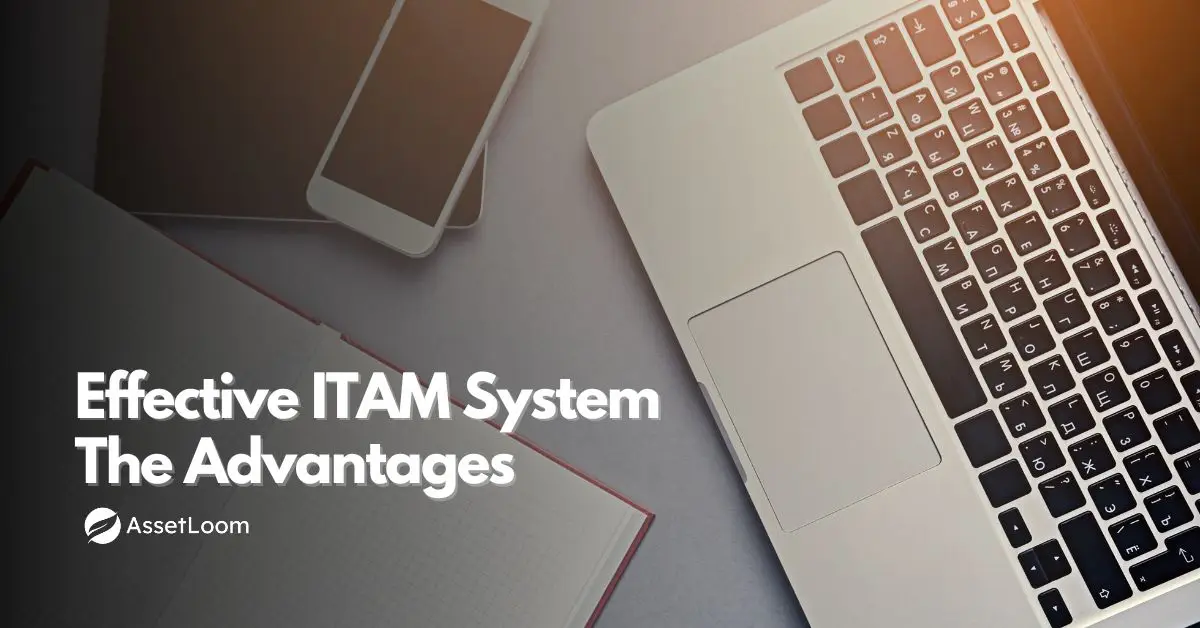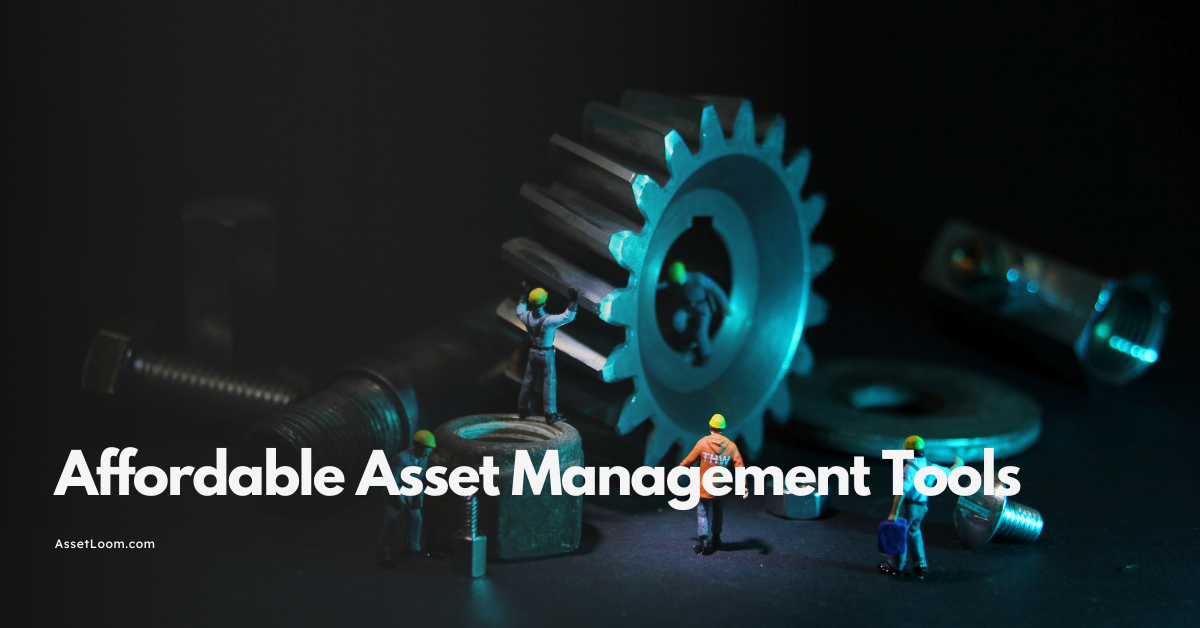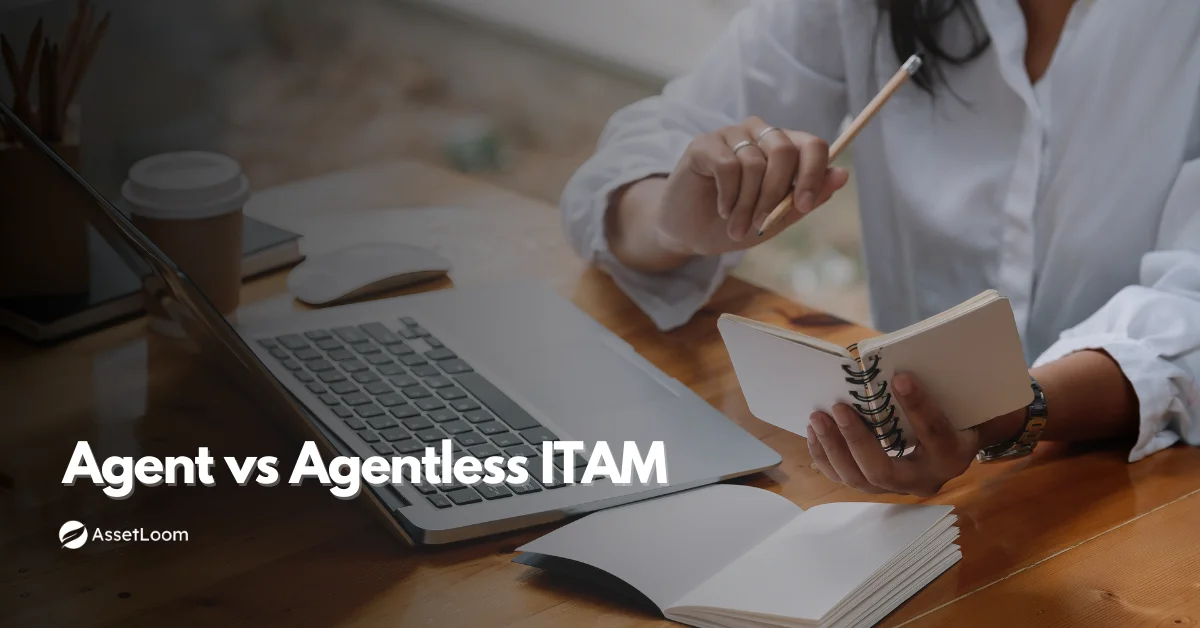Top 7 IT Asset Management Solutions for Efficiency in 2025
Discover the top 7 IT asset management solutions to optimize efficiency, reduce costs, and ensure compliance. Find the perfect fit for your business needs.
Businesses lose millions every year due to misplaced laptops, untracked software licenses, and inefficient IT operations caused by manually tracking assets and poor visibility. In 2025, efficiency isn’t just a goal; it’s essential for reducing costs and staying competitive.
That’s where IT asset management solutions step in, offering a smarter way to track and optimize hardware, software, and cloud resources throughout their lifecycle. IT asset management (ITAM) is the backbone of cost savings, compliance, and productivity in today’s fast-moving tech world. With hybrid workforces, cloud growth, and AI reshaping how we work, the right ITAM tool can make all the difference.
In this blog, we’re breaking down the top 7 IT asset management solutions for 2025. Whether you’re running a small startup or a global enterprise, these tools are designed to streamline your operations and boost efficiency. We’ll dive into their features, pros, cons, and what makes them stand out, giving you the insights you need to choose the perfect fit.
Why IT Asset Management Matters in 2025
The IT landscape is evolving fast. By 2025, hybrid workforces will dominate, cloud computing will soar, and AI will drive smarter decision-making. These trends make IT asset management solutions more critical than ever. Businesses need visibility into their assets - laptops, servers, software licenses, and more - to stay compliant, secure, and cost-efficient through effective hardware asset management.
Effective ITAM delivers big wins: fewer unnecessary costs, enhanced security, and better control over every asset lifecycle. Yet, challenges like tracking assets across remote teams or managing complex software licenses persist. The solutions on this list tackle these pain points head-on, helping businesses minimize security risks, streamline tracking, and optimize IT operations in 2025.
The Top 7 IT Asset Management Solutions for 2025
Let’s explore the top 7 IT asset management solutions that are set to power efficiency in 2025. Each offers unique strengths, but they all share a mission: making ITAM simpler and smarter.
1. ServiceNow IT Asset Management
For enterprises aiming to manage their IT assets with precision, ServiceNow IT Asset Management stands out as a leading choice. Known for its robust lifecycle management, this platform integrates seamlessly with IT service management (ITSM) systems, offering automation and advanced analytics to maintain control over complex environments. It’s a powerhouse designed to scale with the largest organizations while ensuring compliance and visibility across every asset.
-
Pros:
-
Deep ITSM integration unifies workflows.
-
AI-driven insights improve decisions.
-
Scales effortlessly for complex setups.
-
Cons:
-
Expensive for smaller budgets.
-
A steep learning curve requires training.
-
Setup can take time.
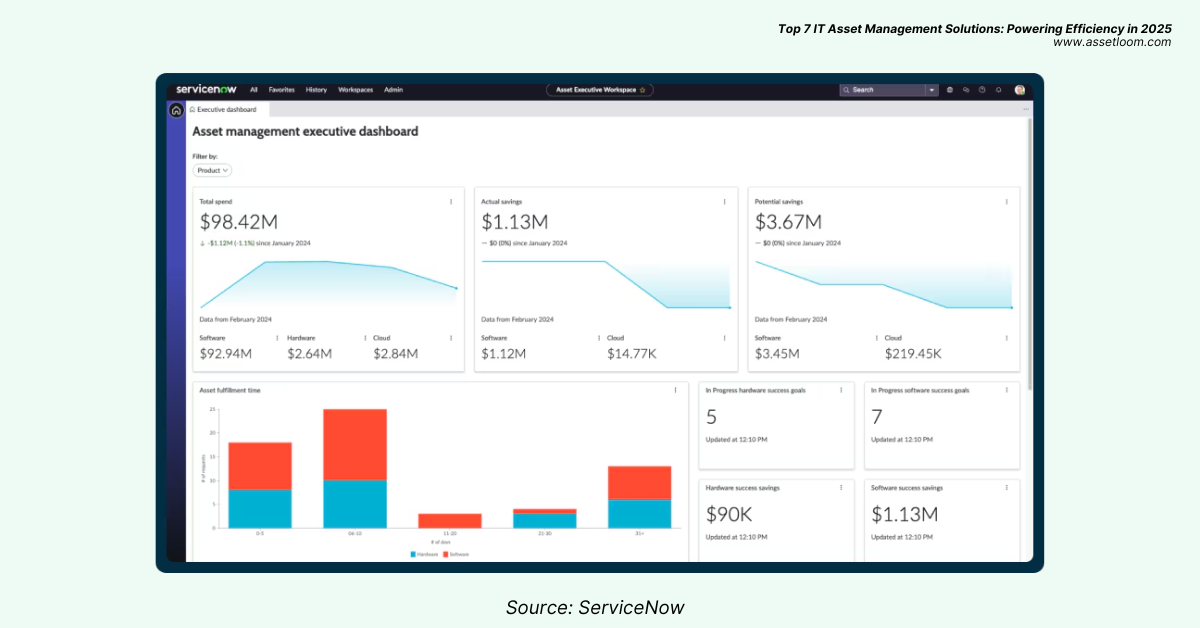
2. Asset Panda
Asset Panda brings simplicity and flexibility to the world of IT asset management (ITAM) with its cloud-based platform. Tailored for ease of use, it empowers small to mid-sized businesses to track assets effortlessly using a mobile app and QR code scanning, all while offering customizable reporting to fit unique needs. Its approachable design and affordable pricing make it a standout for teams that want powerful tools without the complexity.
-
Pros:
-
User-friendly with mobile access.
-
Unlimited users at no extra cost.
-
Highly customizable workflows.
-
Cons:
-
Lacks advanced features like real-time discovery.
-
Not ideal for large, complex IT needs.
-
Support is mostly email-based.
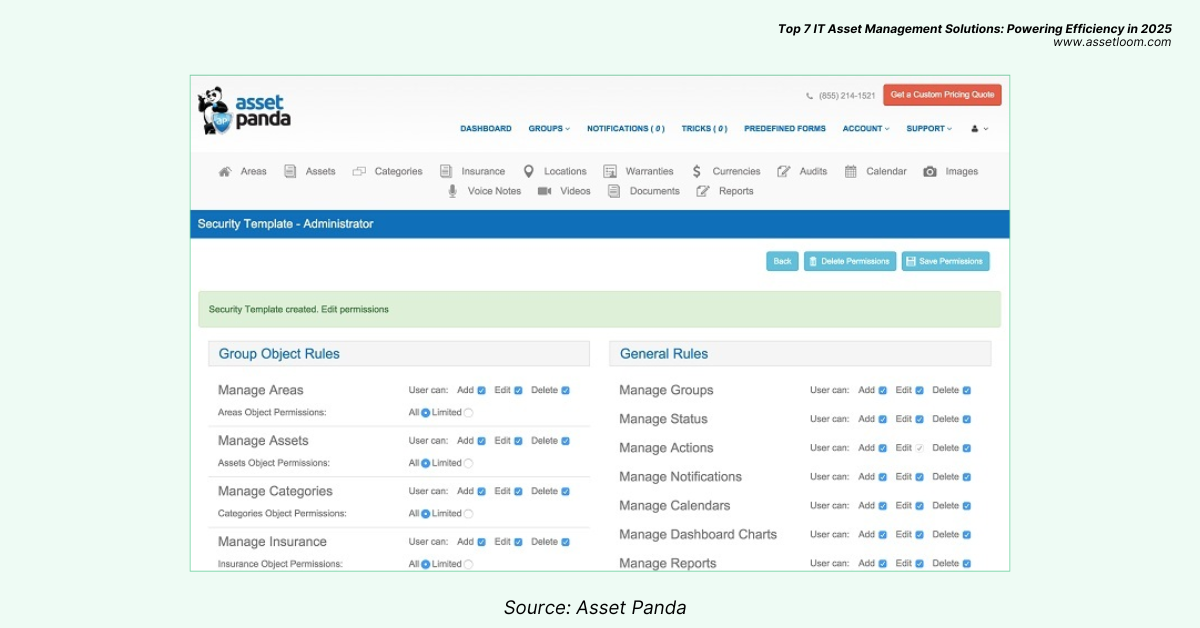
3. Teqtivity
Teqtivity is an innovative player in the ITAM space, offering a solution built for businesses that refuse to be boxed in by limits. With real-time tracking, unlimited users, and seamless integrations, it’s designed to grow alongside companies of any size, delivering visibility and collaboration without restrictions. Its forward-thinking approach makes it a hidden gem for those planning to scale in 2025.
-
Pros:
-
Unlimited scalability without added fees.
-
Real-time asset visibility.
-
Easy third-party integrations.
-
Cons:
-
Lesser-known, with fewer reviews.
-
Features may feel basic for some.
-
Pricing requires a quote.
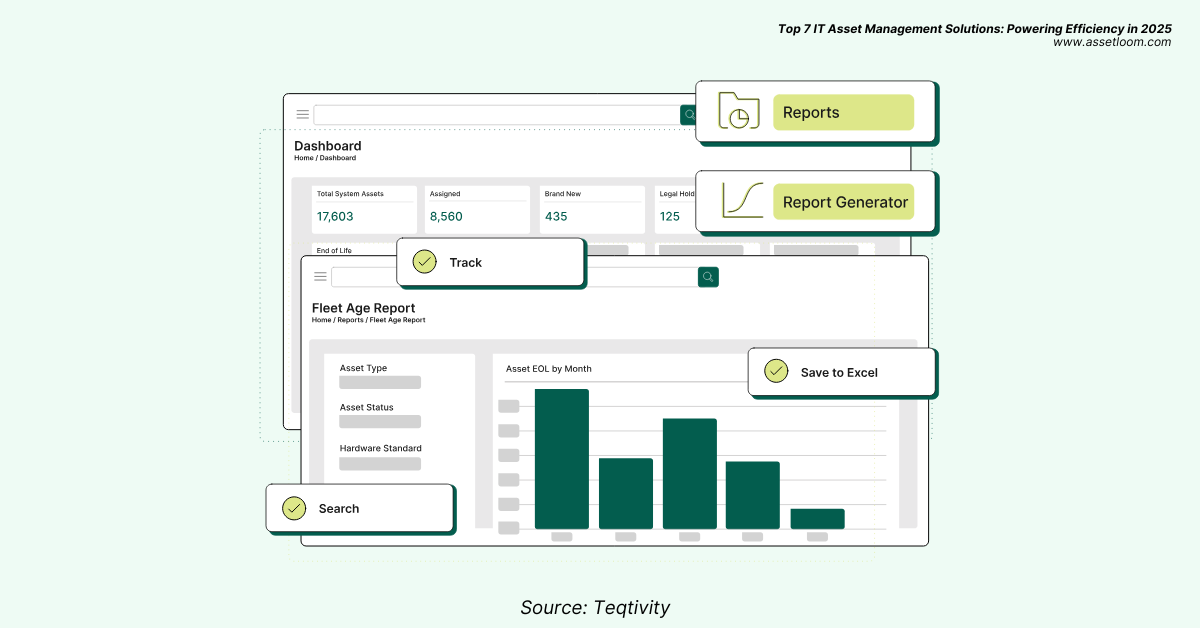
4. ManageEngine AssetExplorer
ManageEngine AssetExplorer delivers a budget-friendly yet powerful ITAM experience for mid-sized businesses. This all-in-one tool excels at automated asset discovery and software license management, helping teams stay compliant without draining their budgets. With its straightforward deployment and strong reporting capabilities, it’s a practical choice for firms seeking value and efficiency.
-
Pros:
-
Low cost with a free tier.
-
Strong reporting and compliance features.
-
Quick to deploy and use.
-
Cons:
-
No dedicated mobile app.
-
Limited customization outside its ecosystem.
-
Free plan restricts features.
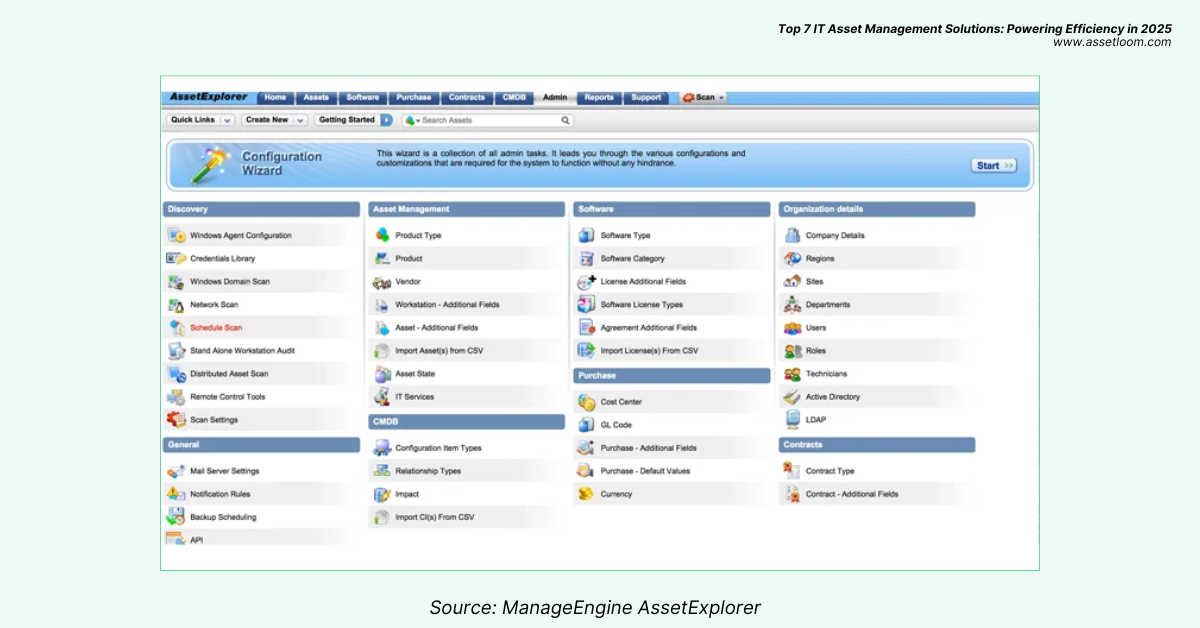
5. Ivanti Neurons for ITAM
Ivanti Neurons for ITAM takes a futuristic approach with AI at its core, offering strategic asset management for tech-savvy organizations. This solution provides predictive insights and full lifecycle tracking, supporting everything from hardware to cloud assets with ease. Its cutting-edge features make it a top pick for businesses ready to embrace automation and innovation in 2025.
-
Pros:
-
AI analytics for proactive management.
-
Full lifecycle visibility.
-
Works on mobile and desktop.
-
Cons:
-
Complex setup needs expertise.
-
Pricing isn’t transparent.
-
Usability can be tricky.
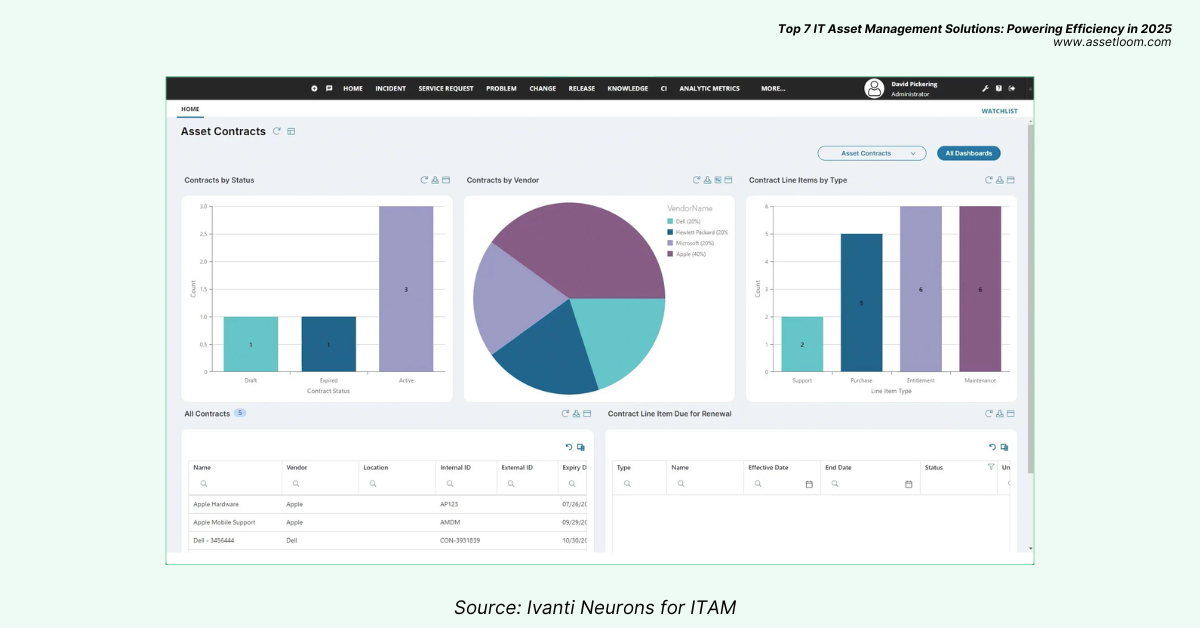
6. Snipe-IT
Snipe-IT is an open-source ITAM solution that prioritizes simplicity and affordability, making it a favorite for startups and small teams. It offers straightforward IT asset tracking and user management, with the added bonus of a free tier that tech-savvy users can customize to their liking. While it lacks some enterprise-level bells and whistles, its cost-effectiveness keeps it in the game.
-
Pros:
-
Free open-source version.
-
Highly customizable.
-
Supports barcode/RFID tagging.
-
Cons:
-
Requires technical setup skills.
-
Lacks advanced enterprise features.
-
Limited official support.
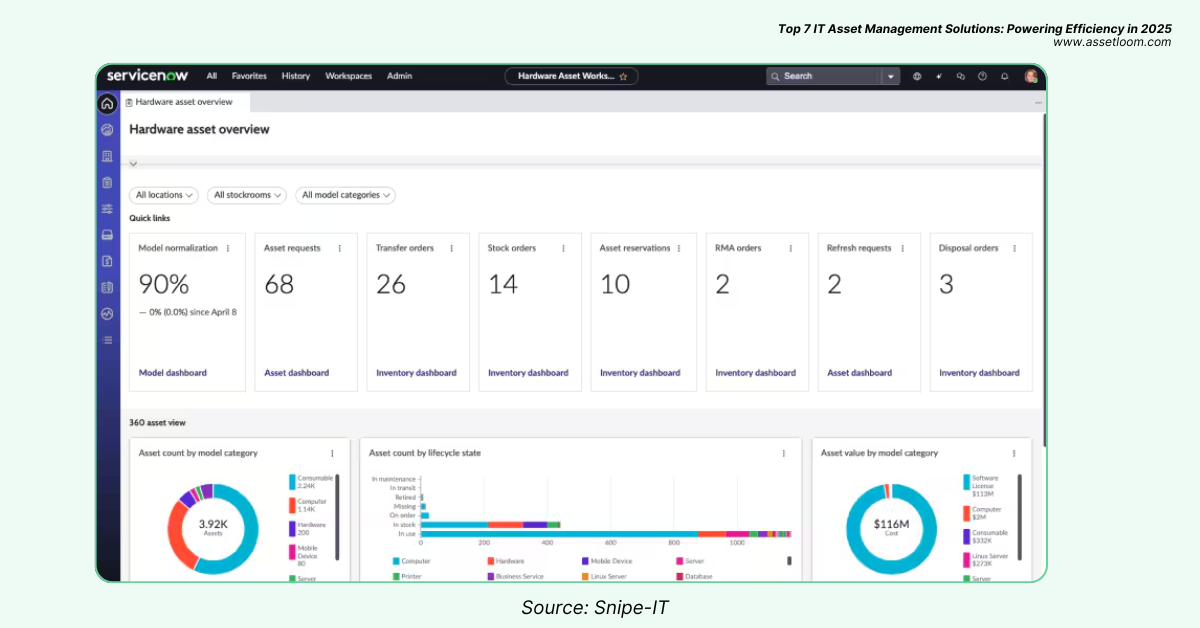
7. SolarWinds Service Desk
SolarWinds Service Desk blends IT asset management with service desk functionality, creating a unified solution for businesses that value streamlined workflows. With automated ticketing, license management, and solid analytics, it’s built to handle IT challenges efficiently. Its integration of ITAM and ITSM makes it a versatile option for teams looking to consolidate their tools.
-
Pros:
-
ITSM-ITAM integration.
-
Scalable pricing options.
-
Mobile app included.
-
Cons:
-
Cluttered interface.
-
Limited workflow customization.
-
Integration challenges with non-SolarWinds tools.
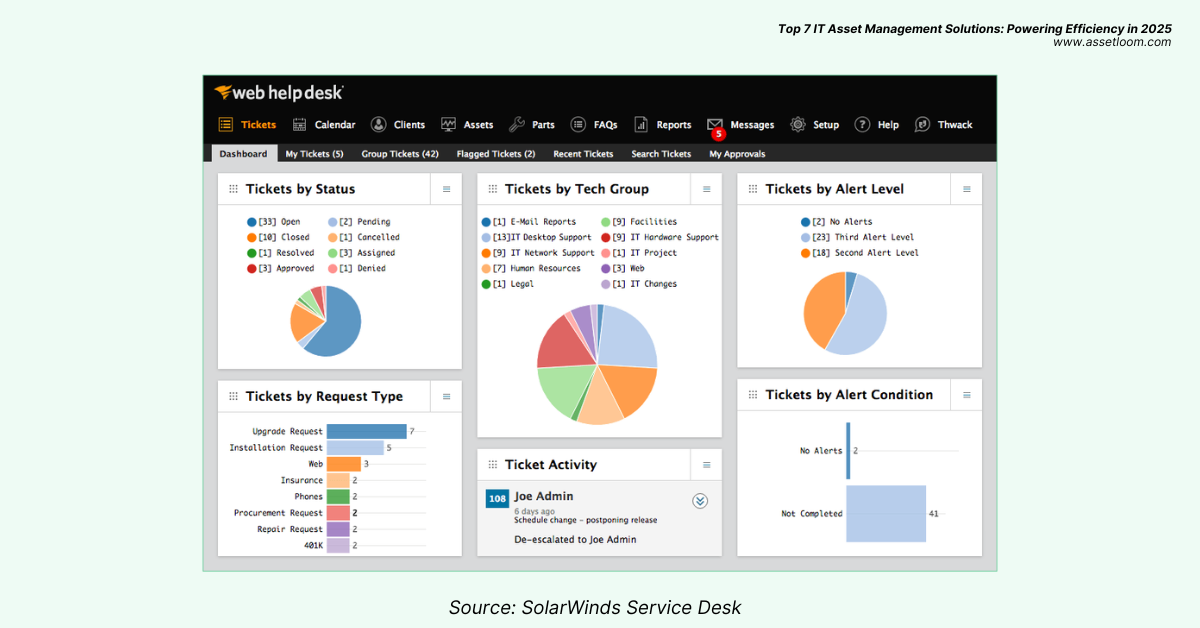
How to Choose the Right Solution for Your Business
With so many IT asset management solutions on the market, like the top 7 we’ve explored, picking the right one can feel daunting. But it doesn’t have to be. By focusing on a few key factors, you can zero in on the tool that best fits your business needs in 2025. Here’s a simple guide to help you choose wisely.
- Asset Volume and Type: First, evaluate what you’re managing. Are you tracking 50 laptops for a small team or thousands of assets, hardware, software, and cloud across an enterprise? A lightweight tool like Snipe-IT suits smaller setups, while ServiceNow handles massive, complex inventories. Match the solution to your current scope and ensure it supports your hardware lifecycle from procurement to retirement.
- Core Priorities: What’s your must-have? If the budget’s tight, ManageEngine offers value; if simplicity rules, Asset Panda delivers. Need advanced features like AI-driven insights? Ivanti Neurons has you covered. Or maybe integrations matter; SolarWinds ties ITAM to ITSM seamlessly. Pinpointing your top need prevents overspending or underperforming.
- Scalability: Growth is inevitable, so your IT asset management system should keep up. Teqtivity’s unlimited users and locations shine for expanding firms, but test any tool’s limits. Will it handle more assets and users a year from now? Free trials let you gauge this firsthand.
- Support and Usability: Don’t overlook the human side. How’s the customer support, fast and reliable, or email-only like Asset Panda’s? Is the interface intuitive, or does it demand training (looking at you, ServiceNow)? User reviews and demos reveal if a solution clicks for your team.
By weighing these factors, you’ll find asset management software that becomes your single source of truth, tailored to your 2025 goals. Most of these tools offer free trials, so take one for a spin. The right choice aligns with your size, needs, and future plans, powering efficiency without the guesswork.
The Future of IT Asset Management: Trends to Watch
IT asset management (ITAM) is evolving rapidly as organizations adapt to hybrid work, cloud expansion, and smarter automation. The next few years will redefine how businesses track, optimize, and secure their IT environments. Here are the top trends reshaping ITAM in 2025 and beyond.
1. AI and Predictive Insights
Artificial intelligence is revolutionizing ITAM by transforming static asset data into actionable intelligence. Instead of simply tracking assets, AI-powered tools can analyze usage patterns, predict hardware failures, and recommend the optimal time for maintenance or replacement. These predictive capabilities reduce downtime, extend asset lifecycles, and improve cost forecasting. For example, AI can detect underutilized servers or expired licenses, helping teams reallocate resources effectively and cut unnecessary spending.
2. Automation and Self-Discovery
Automation is becoming the backbone of modern ITAM. Advanced systems can automatically discover, categorize, and update assets in real time - whether they’re on-premises, in the cloud, or connected remotely. This eliminates the need for manual data entry and ensures accuracy even in dynamic, fast-changing environments. Self-discovery tools also identify shadow IT assets, reducing compliance and security risks. For growing organizations, this automation means scalability without adding administrative workload.
3. Cloud and SaaS Optimization
As businesses continue migrating to the cloud, managing SaaS subscriptions and virtual assets is a growing challenge. Modern ITAM solutions now provide deep visibility into cloud resource consumption, license utilization, and contract renewals. They help prevent duplicate subscriptions, track costs across multiple vendors, and ensure compliance with complex license terms. With multi-cloud environments becoming the norm, ITAM tools are essential for optimizing cloud spending and maintaining governance over dispersed digital assets.
4. Integration with ITSM and Cybersecurity
The boundaries between IT asset management, IT service management (ITSM), and cybersecurity are disappearing. Integrated ecosystems allow organizations to link asset data directly with incident response, vulnerability management, and patching workflows. When ITAM is connected with ITSM platforms like ServiceNow or security tools like SentinelOne, businesses gain complete visibility from asset discovery to risk management. This holistic approach not only improves operational efficiency but also strengthens security posture against emerging threats.
5. Sustainability and Green IT
Sustainability is no longer optional; it’s a business imperative. Forward-thinking organizations are using ITAM to support environmental goals by tracking the energy consumption and lifecycle impact of assets. Tools now provide insights into carbon footprint reduction, e-waste management, and responsible hardware disposal. By extending asset lifecycles, reusing components, and choosing energy-efficient devices, ITAM contributes to both cost savings and corporate sustainability objectives.
In Summary
The future of IT asset management lies in intelligence, integration, and sustainability. As AI, automation, and cloud technologies mature, ITAM is shifting from a reactive tracking function to a proactive strategy that drives business resilience and innovation. Organizations that embrace these trends will not only manage their assets more effectively but also build a more agile, secure, and sustainable IT ecosystem.
Conclusion
In 2025, efficiency isn’t optional; it’s the key to thriving in a tech-driven world. The top 7 IT asset management solutions - ServiceNow, Asset Panda, Teqtivity, ManageEngine, Ivanti Neurons, Snipe-IT, and SolarWinds - offer powerful ways to tame IT chaos.
From ServiceNow’s enterprise-grade scalability to Snipe-IT’s budget-friendly simplicity, each tool brings unique strengths and trade-offs to the table. Whether you’re slashing costs, ensuring compliance, or preparing for growth, these IT asset management solutions have you covered with features like AI analytics, real-time tracking, and seamless integrations.
Choosing the right one hinges on your needs: asset volume, priorities, scalability, and support, as we’ve outlined. The good news? Most offer free trials, so you can test-drive your top pick and see the impact firsthand. At AssetLoom, we’re here to help you navigate these options and stay ahead of 2025’s trends.
Frequently Asked Questions
1. What is the main goal of IT asset management software?
The goal of IT asset management software is to give businesses complete visibility into their hardware, software, and cloud assets. It helps track the entire asset lifecycle—from purchase to disposal—so companies can reduce manual work, cut unnecessary costs, and make data-driven decisions. In short, it creates a single source of truth for all your IT assets.
2. How can IT asset management help reduce costs?
ITAM tools help in reducing costs by automating manual tracking, identifying underused or duplicate assets, and improving license compliance. When everything is centralized and visible, businesses avoid over-purchasing equipment, prevent wasted software spend, and extend their hardware lifecycle through smarter maintenance.
3. What’s the difference between hardware asset management and software asset management?
Hardware asset management focuses on physical devices like laptops, servers, and peripherals throughout their lifecycle, while software asset management handles licenses, installations, and usage tracking. Together, they ensure you’re not just managing inventory, but also protecting against security risks and financial waste.

Subscribe for Expert Tips and Updates
Receive the latest news from AssetLoom, right in your inbox.
